Author:
Janice Evans
Date Of Creation:
24 July 2021
Update Date:
1 July 2024

Content
- Steps
- Part 1 of 3: Understanding Squares of Numbers and Square Roots
- Part 2 of 3: Using the Long Division Algorithm
- Part 3 of 3: Counting Incomplete Squares Quickly
- Tips
While the intimidating look of the square root symbol can make someone who is not good at math cringe, square root problems are not as difficult as they might initially seem. Simple square root problems can often be solved as easily as common multiplication or division problems. On the other hand, more complex tasks may require some effort, but with the right approach, even they will not be difficult for you. Start root-solving today to learn this radically new math skill!
Steps
Part 1 of 3: Understanding Squares of Numbers and Square Roots
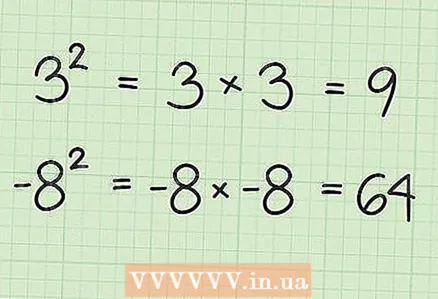 1 Square the number by multiplying it by itself. To understand square roots, it's best to start with the square of numbers. Squaring numbers is pretty simple: squaring a number means multiplying it by itself. For example, 3 squared is the same as 3 × 3 = 9, and 9 squared is the same as 9 × 9 = 81. Squares are marked by writing the small number “2” to the right above the square number. Example: 3, 9, 100, and so on.
1 Square the number by multiplying it by itself. To understand square roots, it's best to start with the square of numbers. Squaring numbers is pretty simple: squaring a number means multiplying it by itself. For example, 3 squared is the same as 3 × 3 = 9, and 9 squared is the same as 9 × 9 = 81. Squares are marked by writing the small number “2” to the right above the square number. Example: 3, 9, 100, and so on. - Try squaring a few more numbers yourself to try out this concept. Remember, squaring a number means that the number should be multiplied by itself. This can be done even for negative numbers. In this case, the result will always be positive. For example: -8 = -8 × -8 = 64.
 2 When it comes to square roots, the process is reversed to squaring. The root symbol (√, also called the radical) essentially means the opposite of the symbol. When you see a radical, you have to ask yourself: "What number can multiply by itself to get the number under the root?" For example, if you see √ (9), then you must find a number that, when squared, would give the number nine. In our case, that number would be three, because 3 = 9.
2 When it comes to square roots, the process is reversed to squaring. The root symbol (√, also called the radical) essentially means the opposite of the symbol. When you see a radical, you have to ask yourself: "What number can multiply by itself to get the number under the root?" For example, if you see √ (9), then you must find a number that, when squared, would give the number nine. In our case, that number would be three, because 3 = 9. - Consider another example and find the root of 25 (√ (25)). This means that we need to find a number that would give us 25 squared. Since 5 = 5 × 5 = 25, we can say that √ (25) = 5.
- You can also think of this as "undoing" the squaring. For example, if we need to find √ (64), the square root of 64, then let's think of this number as 8. Since the root symbol "cancels" the squaring, we can say that √ (64) = √ ( 8) = 8.
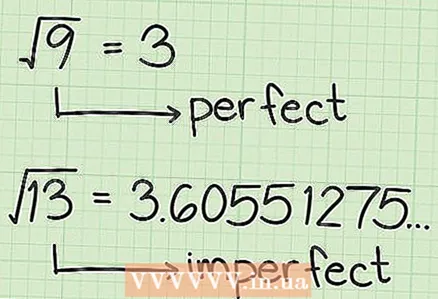 3 Know the difference between perfect and not perfect squaring. Until now, the answers to our problems with root have been good and round numbers, but this is not always the case. The answers to square root problems can be very long and awkward decimal numbers. Numbers whose root is whole numbers (in other words, numbers that are not fractions) are called perfect squares. All of the above examples (9, 25 and 64) are perfect squares because their root will be an integer (3.5 and 8).
3 Know the difference between perfect and not perfect squaring. Until now, the answers to our problems with root have been good and round numbers, but this is not always the case. The answers to square root problems can be very long and awkward decimal numbers. Numbers whose root is whole numbers (in other words, numbers that are not fractions) are called perfect squares. All of the above examples (9, 25 and 64) are perfect squares because their root will be an integer (3.5 and 8). - On the other hand, numbers that, when taken to the root, do not give an integer, are called incomplete squares. If you put one of these numbers under the root, then you get a number with a decimal fraction. Sometimes this number can be quite long. For example, √ (13) = 3.605551275464 ...
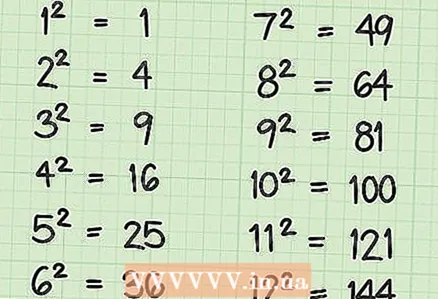 4 Memorize the first 1-12 complete squares. As you've probably already noticed, finding the root of a complete square is pretty easy! Because these tasks are so easy, it's worth remembering the roots of the first dozen complete squares. You will come across these numbers more than once, so take a little time to memorize them early and save time in the future.
4 Memorize the first 1-12 complete squares. As you've probably already noticed, finding the root of a complete square is pretty easy! Because these tasks are so easy, it's worth remembering the roots of the first dozen complete squares. You will come across these numbers more than once, so take a little time to memorize them early and save time in the future. - 1 = 1 × 1 = 1
- 2 = 2 × 2 = 4
- 3 = 3 × 3 = 9
- 4 = 4 × 4 = 16
- 5 = 5 × 5 = 25
- 6 = 6 × 6 = 36
- 7 = 7 × 7 = 49
- 8 = 8 × 8 = 64
- 9 = 9 × 9 = 81
- 10 = 10 × 10 = 100
- 11 = 11 × 11 = 121
- 12 = 12 × 12 = 144
 5 Simplify the roots by removing full squares from it if possible. Finding the root of an incomplete square can sometimes be tricky, especially if you're not using a calculator (see the section below for a few tricks to make this process easier). However, you can often simplify the number under the root to make it easier to work with. To do this, you simply need to factor the number under the root, and then find the square root of the factor and write it outside the root. This is easier than it sounds.Read on for more information.
5 Simplify the roots by removing full squares from it if possible. Finding the root of an incomplete square can sometimes be tricky, especially if you're not using a calculator (see the section below for a few tricks to make this process easier). However, you can often simplify the number under the root to make it easier to work with. To do this, you simply need to factor the number under the root, and then find the square root of the factor and write it outside the root. This is easier than it sounds.Read on for more information. - Let's assume we need to find the square root of 900. At first glance, this seems like a pretty daunting task! However, it won't be that hard if we divide the number 900 by factors. Multipliers are numbers that are multiplied by each other to give a new number. For example, the number 6 can be obtained by multiplying 1 × 6 and 2 × 3, its factors will be the numbers 1, 2, 3 and 6.
- Instead of looking for the root of 900, which is a little tricky, let's write 900 as 9 × 100. Now that 9, which is a perfect square, is separated from 100, we can find its root. √ (9 × 100) = √ (9) × √ (100) = 3 × √ (100). In other words, √ (900) = 3√ (100).
- We can even go even further by dividing 100 by two factors, 25 and 4. √ (100) = √ (25 × 4) = √ (25) × √ (4) = 5 × 2 = 10. So we can say, that √ (900) = 3 (10) = 30
 6 Use imaginary numbers to find the root of a negative number. Ask yourself, what number when multiplied by itself will give -16? It's not 4 or -4, since squaring those numbers will give us a positive number 16. Give up? In fact, there is no way to write the root -16 or any other negative number in normal numbers. In this case, we must substitute imaginary numbers (usually in the form of letters or symbols) so that they appear in place of the root of a negative number. For example, the variable "i" is usually used to root -1. Typically, the root of a negative number will always be the imaginary number (or included in it).
6 Use imaginary numbers to find the root of a negative number. Ask yourself, what number when multiplied by itself will give -16? It's not 4 or -4, since squaring those numbers will give us a positive number 16. Give up? In fact, there is no way to write the root -16 or any other negative number in normal numbers. In this case, we must substitute imaginary numbers (usually in the form of letters or symbols) so that they appear in place of the root of a negative number. For example, the variable "i" is usually used to root -1. Typically, the root of a negative number will always be the imaginary number (or included in it). - Be aware that while imaginary numbers cannot be represented by ordinary numbers, they can still be treated as such. For example, the square root of a negative number can be squared to give these negative numbers, like any other, the square root. For example, i = -1
Part 2 of 3: Using the Long Division Algorithm
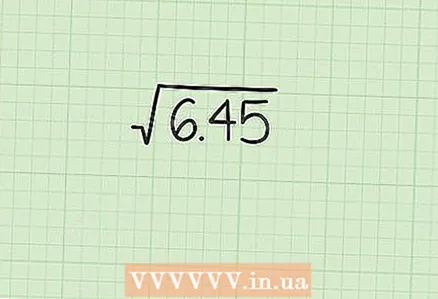 1 Write down the problem with the root as a long division problem. While this can be quite time consuming, this way you can solve the incomplete square root problem without resorting to a calculator. To do this, we will use a solution method (or algorithm) that is similar (but not exactly the same) to regular long division.
1 Write down the problem with the root as a long division problem. While this can be quite time consuming, this way you can solve the incomplete square root problem without resorting to a calculator. To do this, we will use a solution method (or algorithm) that is similar (but not exactly the same) to regular long division. - First, write down the problem with the root in the same form as for long division. Suppose we want to find the square root of 6.45, which is not exactly a perfect square. First, we'll write the usual square symbol, and then we'll write a number below it. Next, we will draw a line above the number so that it appears in a small "box", just like in long division. After that we have a root with a long tail and a 6.45 number below it.
- We will write numbers above the root, so be sure to leave some space there.
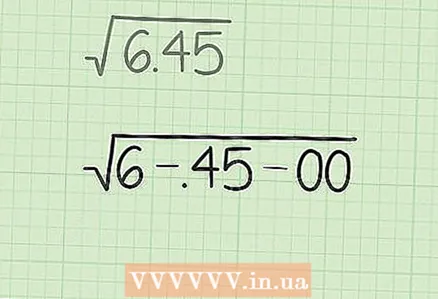 2 Group the numbers in pairs. In order to start solving the problem, it is necessary to group the digits of the number under the radical in pairs, starting with a decimal point. If you want, you can make small marks (like dots, oblique lines, commas, etc.) between pairs so as not to get confused.
2 Group the numbers in pairs. In order to start solving the problem, it is necessary to group the digits of the number under the radical in pairs, starting with a decimal point. If you want, you can make small marks (like dots, oblique lines, commas, etc.) between pairs so as not to get confused. - In our example, we have to pair the number 6.45 as follows: 6-, 45-00. Note that there is a "remaining" digit on the left - this is normal.
 3 Find the largest number whose square is less than or equal to the first "group". Start with the first number or pair on the left. Pick the largest number whose square is less than or equal to the remaining “group”. For example, if the group were 37, you would choose the number 6 because 6 = 36 37 and 7 = 49> 37. Write this number above the first group. This will be the first number in your answer.
3 Find the largest number whose square is less than or equal to the first "group". Start with the first number or pair on the left. Pick the largest number whose square is less than or equal to the remaining “group”. For example, if the group were 37, you would choose the number 6 because 6 = 36 37 and 7 = 49> 37. Write this number above the first group. This will be the first number in your answer. - In our example, the first group in 6-, 45-00 will be the number 6. The largest number that is less than or equal to 6 in the square is 2 = 4. Write the number 2 above the number 6 under the root.
 4 Double the number you just wrote, then root it and subtract it. Take the first digit of your answer (the number you just found) and double it. Write the result under your first group and subtract to find the difference. Drop the next couple of numbers next to the answer. Finally, write on the left the last double digit of the first digit of your answer, and leave a space next to it.
4 Double the number you just wrote, then root it and subtract it. Take the first digit of your answer (the number you just found) and double it. Write the result under your first group and subtract to find the difference. Drop the next couple of numbers next to the answer. Finally, write on the left the last double digit of the first digit of your answer, and leave a space next to it. - In our example, we'll start by doubling the number 2, which is the first number in our answer. 2 × 2 = 4.Then we subtract 4 from 6 (our first "group"), getting 2. Then we omit the next group (45) to get 245. And finally, on the left, we will write the number 4 again, leaving a small space at the end, here like this: 4_
 5 Please fill in the blank. Then you must add a digit to the right side of the recorded number, which is on the left. Choose a digit, multiplying which with your new number, you would get the largest possible result, but which would be less than or equal to the "omitted" number. For example, if your "omitted" number is 1700, and your number on the left is 40_, you need to write the number 4 in the space, since 404 × 4 = 1616 1700, while 405 × 5 = 2025. The digit found in this step and will be the second digit of your answer, so you can write it above the root sign.
5 Please fill in the blank. Then you must add a digit to the right side of the recorded number, which is on the left. Choose a digit, multiplying which with your new number, you would get the largest possible result, but which would be less than or equal to the "omitted" number. For example, if your "omitted" number is 1700, and your number on the left is 40_, you need to write the number 4 in the space, since 404 × 4 = 1616 1700, while 405 × 5 = 2025. The digit found in this step and will be the second digit of your answer, so you can write it above the root sign. - In our example, we have to find a number and write it in spaces 4_ × _, which will make the answer as large as possible, but still less than or equal to 245. In our case, it is 5. 45 × 5 = 225, while 46 × 6 = 276
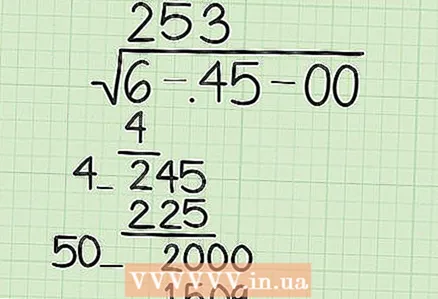 6 Continue to use blank numbers to find the answer. Continue solving this modified long division until you start getting zeros when you subtract the "omitted" number, or until you get the level of precision you want. When you're done, the numbers you used to fill in the blanks in each step (plus the very first number) will make up the number in your answer.
6 Continue to use blank numbers to find the answer. Continue solving this modified long division until you start getting zeros when you subtract the "omitted" number, or until you get the level of precision you want. When you're done, the numbers you used to fill in the blanks in each step (plus the very first number) will make up the number in your answer. - Continuing with our example, we subtract 225 from 245 to get 20. Then, we drop the next pair of numbers, 00, to get 2000. Double the number above the root sign. We get 25 × 2 = 50. Solving the example with spaces, 50_ × _ = / 2,000, we get 3. At this stage, we will have 253 written above the radical, and repeating this process again, our next number will be 9.
 7 Move the decimal point forward from the original dividend number. To complete your answer, you must put the decimal point in the correct place. Fortunately, this is fairly easy to do. All you have to do is align it with the original number point. For example, if the number 49.8 is under the root, you will need to put a full stop between the two numbers above the nine and eight.
7 Move the decimal point forward from the original dividend number. To complete your answer, you must put the decimal point in the correct place. Fortunately, this is fairly easy to do. All you have to do is align it with the original number point. For example, if the number 49.8 is under the root, you will need to put a full stop between the two numbers above the nine and eight. - In our example, there is 6.45 under the radical, so we just move the period and put it between the numbers 2 and 5 in our answer, and get the answer equal to 2.539.
Part 3 of 3: Counting Incomplete Squares Quickly
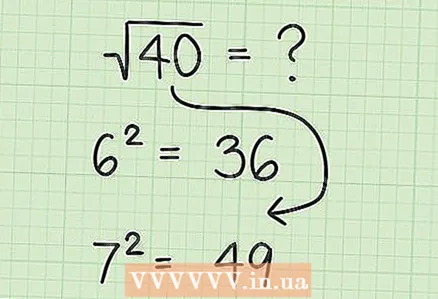 1 Find incomplete squares by counting them. Once you memorize complete squares, finding the root of incomplete squares becomes much easier. Since you already know a dozen perfect squares, any number that falls in the area between these two complete squares can be found by reducing everything to a rough count between these values. Start by finding two complete squares with your number in between. Then determine which of these numbers your number is closer to.
1 Find incomplete squares by counting them. Once you memorize complete squares, finding the root of incomplete squares becomes much easier. Since you already know a dozen perfect squares, any number that falls in the area between these two complete squares can be found by reducing everything to a rough count between these values. Start by finding two complete squares with your number in between. Then determine which of these numbers your number is closer to. - For example, suppose we need to find the square root of 40. Since we memorized perfect squares, we can say that 40 is between 6 and 7, or 36 and 49. Since 40 is greater than 6, its root will be greater than 6, and since it is less than 7, its root will also be less than 7. 40 is slightly closer to 36 than to 49, so the answer is likely to be slightly closer to 6. In the next few steps, we will narrow our answer.
 2 Count the square root to the first decimal place. Once you have selected two complete squares between which your number is, it all comes down to your count until you get the answer you want. The more you count, the more accurate your answer will be. Start by choosing where to put the decimal point in your answer. It doesn't have to be correct, but it will save you time if you use logic and put an end as close as possible to the correct answer.
2 Count the square root to the first decimal place. Once you have selected two complete squares between which your number is, it all comes down to your count until you get the answer you want. The more you count, the more accurate your answer will be. Start by choosing where to put the decimal point in your answer. It doesn't have to be correct, but it will save you time if you use logic and put an end as close as possible to the correct answer. - In our example, a reasonable estimate of the square root of 40 might be 6.4, since from the above information, we know that the answer is closer to 6 than to 7.
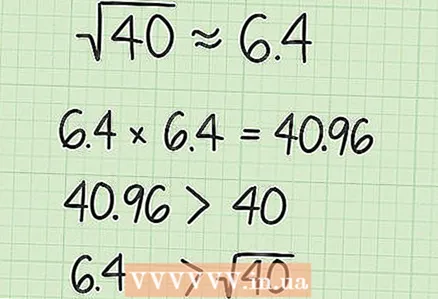 3 Multiply the approximate number by itself. The next thing you should do is square the approximate number. You will most likely be out of luck and will not receive the original number. It will be either slightly larger or slightly smaller.If your result is too high, then try again, but with a slightly lower estimate (and vice versa if the result is too low).
3 Multiply the approximate number by itself. The next thing you should do is square the approximate number. You will most likely be out of luck and will not receive the original number. It will be either slightly larger or slightly smaller.If your result is too high, then try again, but with a slightly lower estimate (and vice versa if the result is too low). - Multiply 6.4 by itself, and you get 6.4 × 6.4 = 40.96, which is slightly more than the original number.
- Since our answer turned out to be larger, we must multiply the number by one tenth less by the approximate and get the following: 6.3 × 6.3 = 39.69. This is slightly less than the original number. This means that the square root of 40 is between 6.3 and 6.4. Again, since 39.69 is closer to 40 than 40.96, we know that the square root will be closer to 6.3 than 6.4.
 4 Continue calculating. At this point, if you are happy with your answer, you can simply take the first guess you guess. However, if you want a more accurate answer, all you have to do is choose an approximate value with two decimal places that puts that approximate value between the first two numbers. Continuing this count, you can get three, four or more decimal places for your answer. It all depends on how far you want to go.
4 Continue calculating. At this point, if you are happy with your answer, you can simply take the first guess you guess. However, if you want a more accurate answer, all you have to do is choose an approximate value with two decimal places that puts that approximate value between the first two numbers. Continuing this count, you can get three, four or more decimal places for your answer. It all depends on how far you want to go. - For our example, let's pick 6.33 as an approximate value with two decimal places. Multiply 6.33 by itself to get 6.33 × 6.33 = 40.0689. since this is slightly larger than our number, we will take a smaller number, for example, 6.32. 6.32 × 6.32 = 39.9424. This answer is slightly less than our number, so we know that the exact square root is between 6.32 and 6.33. If we wanted to continue, we would continue to use the same approach to get an answer that is getting more and more accurate.
Tips
- To quickly find a solution, use the calculator. Most modern calculators can find the square root of a number instantly. All you need to do is enter your number and then click on the root button. For example, to find the root 841, you would have to press 8, 4, 1 and (√). As a result, you will get the answer 39.



